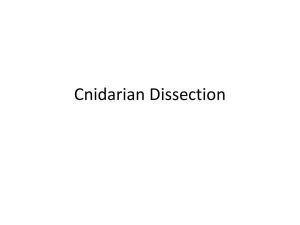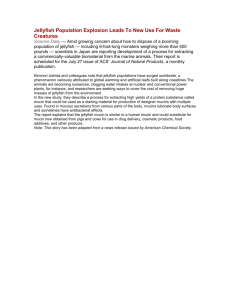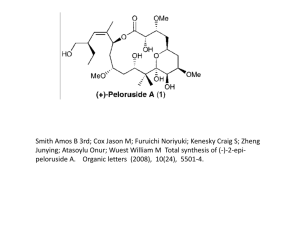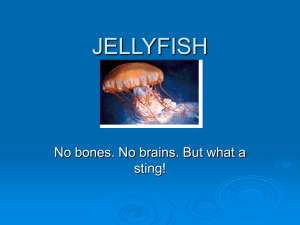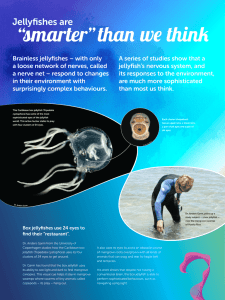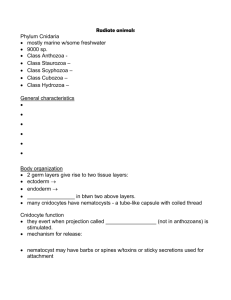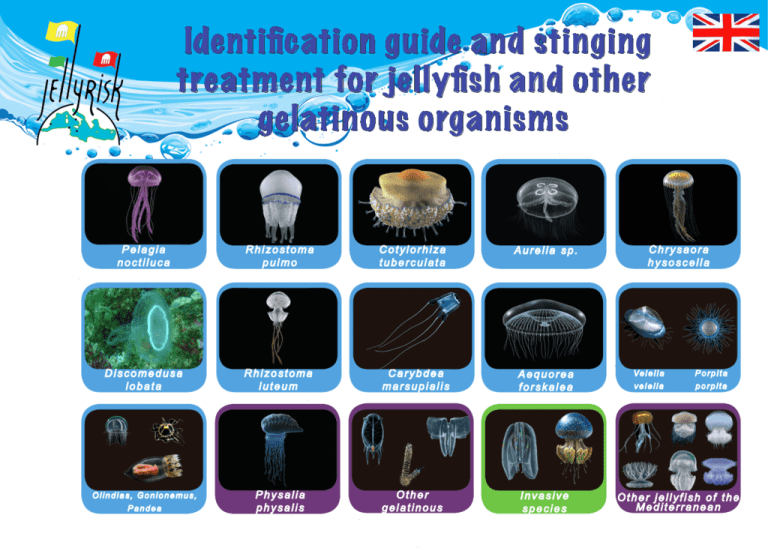
Identification guide and stinging
treatment for jellyfish and other
gelatinous organisms
COTYLORHIZA
PELAGIA
PELAGIA
PELAGIA
RHIZOSTOMA
RHIZOSTOMA
RHIZOSTOMA
A. Gennari 2013
Pelagia
noctiluca
Rhizostoma
pulmo
A. Gennari
A. Gennari
20132013
A. Gennari
A. Gennari
2013
2013
A. Gennari 2013
Cotylorhiza
tuberculata
Aurelia sp.
Chrysaora
hysoscella
A. Gennari 2013
AEQUOREA
RHIZOSTOMA LUTEUM
Discomedusa
lobata
A. Gennari 2013
AEQUOREA
AEQUOREA
RHIZOSTOMA LUTEUM
RHIZOSTOMA LUTEUM
Rhizostoma
luteum
A. Gennari 2013
A. Gennari 2013
Carybdea
marsupialis
Aequorea
forskalea
Other
gelatinous
Invasive
species
A. Gennari 2013
A. Gennari
A. Gennari
2013 2013
Ve l e l l a
Porpita
velella
porpita
PHYSALIA
Olindias, Gonionemus,
Pandea
Physalia
physalis
A. Gennari 2013
Other jellyfish of the
Mediterranean
Technical card of Jellyfish
Cnidarians are a group of animals that include
jellyfish and other stinging gelatinous organisms,
which have specific cells called cnidocists that
are like microsyringes that inject toxic substances used for feeding and defence. Cnidocists are
distributed over the whole body of the jellyfish,
but are concentrated in the tentacles. The level of
toxicity for humans is different depending on the
jellyfish species. The majority of accidental contacts between humans and jellyfish occur during
bathing or with dead animals or with their tentacles in the beach. The toxic capacity remains for a
long time after the jellyfish dies.
In this guide, jellyfish are classified according to
the species-specific stinging capacity in the
following categories:
General diagram
of a jellyfish
Umbrella
Stomach
Marginal
tentacles
Ectoderm
Mesoglea
Endoderm
Manubrium
Oral arms or
tentacles
HIGH STINGING
STINGING
MILD STINGING
HARMLESS
1
Jellyfish Life Cycle
1
6
1 Adults reproduce
sexually with external
fertilisation
2 The planula larvae
swims freely for a short
time
3 The planula fix on a
2
substrate and transform
into a polyp
4 The polyp undergoes
the strobilation process
5 Dividing itself in seg-
ments and producing
ephyras
6 Each ephyra or juve-
nile jellyfish swims freely
until it becomes a new
adult jellyfish
5
3
4
Jellyfish present different life cycles depending on the species.
The one presented in this guide is the most common for the
Spanish Mediterranean coastal jellyfish, including Aurelia sp.,
R. pulmo, C. tuberculata, C. hysoscella, R. luteum,
D. lobata and P. punctata.
2
Je llyf ish that may occur in the
Spanish Me di te r rane an coas t
Pelagia noctiluca
Common name: Mauve stinger
3
Umbrella diameter up to 20 cm
Pink-red colour. Hemispheric umbrella with 4 thick oral arms and
8 marginal tentacles (up to 2 m length). The surface of the
umbrella is covered with brownish warts. Juveniles may be light
brown colour instead of pink.
HIGH STINGING
VERY FREQUENT
All-year round
PELAGIA
A. Gennari
2013
A. Gennari 2013
Pelagia noctiluca
This species is considered one of the most abundant and
important in the western Mediterranean.
It is an oceanic species and its life cycle is completely
pelagic (without a polyp stage). Its presence in coastal
waters relies on environmental and climatological conditions. It is very frequent during spring and summer seasons, even though it can be present during the whole year.
It has bioluminescence and it is often accompanied by
juvenile fishes from the Carangidae family.
4
Je llyf ish that may occur in the
Spanish Me di te r rane an coas t
Rhizostoma pulmo
Common name: Barrel jellyfish
Umbrella diameter up to 40 cm
Bell-shaped umbrella, white-bluish colour with a violet border.
No marginal tentacles and 8 white-bluish and thick oral arms,
fused together with no branching.
5
STINGING
VERY FREQUENT
Spring - Summer - Autumn
RHIZOSTOMA
© S. PIRAINO
© A. OLARIAGA
A. Gennari 2013
A. Gennari 2013
Rhizostoma pulmo
It is one of the biggest jellyfish along
the Spanish Mediterranean coast. The
small medusae are produced in spring
and the larger adults are more evident in summer and at the beginning
of autumn. It is considered a coastal
species, generally present at or near
the surface. It is usually accompanied
by crabs and juveniles fishes from the
Carangidae family.
6
Je llyf ish that may occur in the
Spanish Me di te r rane an coas t
Cotylorhiza tuberculata
Common name: Fried egg jellyfish
7
Umbrella diameter up to 35 cm
Flattened umbrella, brown-yellowish, with a large central protuberance in dark orange colour. Without marginal tentacles,
8 oral arms with 3 appendages at the end, button-shaped and
white or blue in colour.
MILD STINGING
VERY FREQUENT
End of summer - Autumn
COTYLORHIZA
A. Gennari 2013
A. Gennari 2013
A. Gennari 2013
Cotylorhiza tuberculata
It is an endemic species of the
Mediterranean, coastal and with
preference for warmer waters.
The adults are more abundant at
the end of the summer and beginning of autumn. It is often accompanied by juvenile fishes from the
Carangidae family.
8
Je llyf ish that may occur in the
Spanish Me di te r rane an coas t
Aurelia sp.
Common name: Moon jellyfish
Umbrella diameter up to 25 cm
Plate-shaped umbrella. Transparent colour. Many short marginal tentacles and 4 long oral arms. Four horseshoe-shaped
reproductive organs purple-violet in colour.
9
MILD STINGING
FREQUENT
Spring- Summer
Aurelia sp.
Cosmopolitan species present in all the
world’s oceans. The frequency of this species
in the Spanish Mediterranean had decreased
in recent years. It is more frequent at the end
of spring. It is a coastal species and it may be
found even in estuaries and ports.
10
Je llyf ish that may occur in the
Spanish Me di te r rane an coas t
Chrysaora hysoscella
Common name: Compass jellyfish
White-yellowish umbrella, with 16 brown bands on the
surface. It has 4 long oral arms and 24 long, thin
marginal tentacles.
11
Umbrella diameter up to 30 cm
HIGH STINGING
LOW FREQUENCY
Spring
Chrysaora hysoscella
It is a pelagic rather big species. It may be quite abundant in some areas
of the Spanish Mediterranean although it rarely forms swarms. It is
commonly frequent in spring. It is often accompanied by juvenile fishes
from the Carangidae family.
12
Je llyf ish that may occur in the
Spanish Me di te r rane an coas t
Discomedusa lobata
Common name: Discomedusa
13
Umbrella diameter up to 15 cm
Flattened umbrella, transparent and with whitish colour gonads. It has 4 oral arms and 24 thin marginal tentacles. It is
a rare species in the Mediterranean, but in 2013 it showed
important abundances in some coastal areas.
MILD STINGING
LOW FREQUENCY
Spring - Summer
Je llyf ish that may occur in the
Spanish Me di te r rane an coas t
Rhizostoma luteum
Common name: does not have
RHIZOSTOMA LUTEUM
Umbrella diameter up to 70 cm
Hemispheric umbrella without the
characteristic violet border of the species
R. pulmo. No marginal tentacles and 8 oral
arms with a grey-black colouring in the
distal part, that may extend even more than
the individual’s length. It may observed
alone or forming swarms.
In the Mediterranean it had not been
recorded since 1827, but in 2012 new
records of this species were reported on the
Spanish Mediterranean coast.
STINGING
VERY RARE
A. Gennari 2013
Spring - Summer - Autumn
14
Je llyf ish that may occur in the
Spanish Me di te r rane an coas t
Carybdea marsupialis
Common name: Box jellyfish
Cube-shaped umbrella with 4 long tentacles. Transparent bluish
or whitish colour. Inhabit very shallow waters.
15
Umbrella up to 5 cm
HIGH STINGING
FREQUENT
Summer - Autumn
© FERDINANDO BOERO
Carybdea marsupialis
C. marsupialis is a box jellyfish, but its venom is not lethal. The
preferred environment for this species seems to be the sandy
substrate, and it swims over the bottom during the day moving
to the surface during the night. Its presence in certain areas of
the Spanish Mediterranean coast is very abundant.
16
Je llyf ish that may occur in the
Spanish Me di te r rane an coas t
Aequorea forskalea
Common name: Crystal jelly
Umbrella diameter up to 25 cm
Plate-shaped umbrella with a thicker centre. The umbrella is
transparent with blue radial canals. Numerous, thin marginal
tentacles and no oral arms.
17
MILD STINGING
FREQUENT
Spring
A. Gennari 2013
A. Gennari 2013
Aequorea forskalea
This species inhabits temperate to tropical waters, in
coastal and littoral areas, occuring even occasionally in
the open sea. It is a frequent species in the Spanish
Mediterranean, being more common in spring and
forming huge occasional swarms. It has bioluminescence
and it is often accompanied by juvenile fishes from the
Carangidae family.
18
Je llyf ish that may occur in the
Spanish Me di te r rane an coas t
Velella velella
Common name: Purple sailor
19
Blue oval disc with a small sail. It is a hydromedusa which life
cycle phase usually obser ved is a floating polyp colony located
underneath the skirt in form of tentacles. When alive, the edge
is covered with a soft tissue.
Disc diameter up to 8 cm
MILD STINGING
FREQUENT
End of winter - Spring
Velella velella
It is a very frequent species in the Spanish
Mediterranean especially during spring. It may be
present in huge swarms reaching even several
kilometres. The polyps of the colony produce small
jellyfish that go deep in the sea where they reproduce
sexually and produce small lar vae that go to the
surface and form new floating colonies.
20
Je llyf ish that may occur in the
Spanish Me di te r rane an coas t
Porpita porpita
Common name: Blue button jelly
Disc diameter up to 5 cm
PORPITA
A. Gennari 2013
21
Small hydromedusa of intense blue colour. Colonial organism
that lives at the surface of the open sea, but may be found in
high number in coastal areas. It is seen occasionally in the
Mediterranean Sea.
MILD STINGING
VERY RARE
Spring
Je llyf ish that may occur in the
Spanish Me di te r rane an coas t
Olindias phosphorica
Common name: Cigar jellyfish
Umbrella diameter up to 8 cm
Transparent hydromedusa with 4 radial opaque white stripes.
The umbrella is surrounded by blue or dark red small tentacles.
In the Spanish Mediterranean coast no large swarms are
usually obser ved, but it may be very abundant locally.
HIGH STINGING
LOW FREQUENCY
Summer - Autumn
22
Je llyf ish that may occur in the
Spanish Me di te r rane an coas t
Gonionemus vertens
Common name: Orange striped jellyfish
23
Umbrella diameter 2 - 4 cm
Transparent umbrella with orange gonads. Numerous tentacles,
up to 90, with suckers at the ends; thus, it is frequent to find it
attached to sea algae. It is s common species in the
Mediterranean.
HIGH STINGING
FREQUENT
Spring - Summer
Je llyf ish that may occur in the
Spanish Me di te r rane an coas t
Pandea conica
Common name: does not have
Length up to 6 cm
Hydromedusa with large tentacles used to capture gelatinous
prey. The reddish gonads may be seen through the umbrella. It is
common i surface waters in spring. There are no stinging records
known for this species.
MILD STINGING
FREQUENT
Spring
24
O ther ge lat inous organisms
that may occur in the
Spanish Me di te r rane an coas t
Physalia physalis
Common name: Portuguese man-of-war Floating part 30 cm long-10 cm wide
25
It is a floating colony with a gas-filled float. Opaque violet colour
with a sail at the top. The immersed part has a long, thin, blue
tentacles that may reach up to 20 m length. Native from the
Atlantic Ocean.
HIGH STINGING
LOW FREQUENCY
Spring
O the r ge lat inous organisms
that may occur in the
Spanish Me di te r rane an coas t
LEUCOTHEA
A. Gennari 2013
A. Gennari
2013
Forskalia sp.
Siphonophore
Gelatinous planktonic tunicates.
Complex life cycle with solitary
phases alternated with colonial
phases. They form chains that
may reach 7 or more metres
length.
Leuckotea multicornis
Ctenophore
Salps
HARMLESS
26
Invasi ve spe cie s pre se nt on the
Spanish Me di te r rane an coas t
Mnemiopsis leidyi
Common name: Glow ball or sea walnut
Length up to 12 cm
© D. ANGEL
Invasive ctenophore native to the eastern Atlantic.
Bulb shape. Transparent. Adults have 8 ciliated lines and no
tentacles. Organisms with iridescence and bioluminescence.
27
HARMLESS
FREQUENT
All-year round
Larva de M. leidyi
MNEMIOPSIS
Mnemiopsis leidyi
The ctenophore Beroe
ovata, native from the
eastern Atlantic, is the
specific natural
predator of M. leidyi.
It is an invasive species
that occurs in some
areas of the
Mediterranean.
This invasive species is a ctenophore,
thus it doesn’t have cnidocists (stinging
cells) and it is harmless to humans, but
very detrimental for marine invaded
ecosystems.
A. Gennari 2013
A. Gennari 2013
28
Invasi ve spe cie s pre se nt on the
Spanish Me di te r rane an coas t
Phyllorhiza punctata
Common name: Australian spotted jelly
Umbrella diameter up to 70 cm
© M. MARAMBIO
29
Invasive jellyfish native from the Indo-Pacific.
Hemispheric umbrella with white crystalline spots uniformly
distributed. No marginal tentacles and 8 thick oral arms with
14 transparent appendages at the end.
MILD STINGING
LOW FREQUENCY
Spring - Summer - Autumn
Phyllorhiza punctata
This invasive species reached the Mediterranean
through the Suez Canal and expanded to the
whole basin. In the year 2010 was first described in the south of the Catalan coast in the Ebro
Delta. It is a mild stinging jellyfish thus, it does
not represent a problem to humans but it does
for the marine ecosystems.
30
Je llyf ish that may occur in o the r
place s in the Me di te r rane an
RHOPILEMA
31
Pelagia benovici
Drymonema dalmatinum
New species. Recently
(2014) described in the
Mediterranean. Currently,
no records for the Spanish
Mediterranean coast.
It is the biggest
Mediterranean jellyfish and
the least known of all. It has
low frequency.
HIGH STINGING
HIGH STINGING
Rhopilema nomadica
Introduced species. It is
native from the Indo-Pacific.
It is an established species in
the eastern Mediterranean
and dominates the pelagic
ecosystems.
A. Gennari 2013
HIGH STINGING
Je llyf ish that may occur in o the r
place s in the Me di te r rane an
Cassiopea andromeda
CASSIOPEA
Introduced species in the
Mediterranean. Native from
the Indo-Pacific. Currently it
is present on some areas of
the eastern Mediterranean.
A. Gennari 2013
MILD STINGING
Catostylus tagi
Marivagia stellata
MARIVAGIA
Introduced species that
entered the Mediterranean
through the Gibraltar Strait.
Usually observed alone, no
swarms.
Introduced species in the
Mediterranean. Native from
the Indo-Pacific. Usually
observed alone, no swarms.
MILD STINGING
MILD STINGING
A. Gennari 2013
32
Je llyf ish s t ing t re atme nt
re comme ndat ions
Some jellyfish species may sting humans, determining local reactions and occasional
systemic effects. Treatment of jellyfish envenomation aims to attenuate venom effects, prevent
further envenomation from residual jellyfish pieces, and keep in check occasional systemic
reactions, including shock.
Depending on the jellyfish species, there is evidence and consensus on oral/topical
analgesics, hot water and ice packs as effective painkillers. For a few species (see below), a short
application of domestic vinegar may prevent further discharge of unfired jellyfish stinging cells left
on the skin.
33
Most treatment approaches are presently founded on relatively weak evidence and further
research is strongly recommended. Dissemination of appropriate treatment modalities is
deployed in the framework of MED-JELLYRISK Project to better inform and educate all the
personnel working at beach and those at risk.
According to the current medical literature about jellyfish sting treatments, in the present
guide a synthesis is recommended for the most relevant species of the Spanish Mediterranean
coast and all procedures with no consensus are excluded.
Imme diate act ion pro tocol
in case of je llyf ish s t ing
A decision tree is presented next in order to facilitate
the protocol implementation
If you have been stung by a jellyfish,
do you recognize the species that caused the sting?
NO
P. physalis
O. phosphorica
(page. 35)
C. marsupialis
Follow the
instructions
of the
GENERAL
PROTOCOL
C. hysoscella
R. pulmo
(page. 35)
P. noctiluca
Follow the instructions of the
GENERAL JELLYFISH
STINGING PROTOCOL
YES
Follow the Follow the Follow the
instructions instructions instructions
of the
of the
of the
PROTOCOL PROTOCOL PROTOCOL
CASE 1
CASE 2
CASE 3
(page. 36)
(page. 37)
(page. 38)
34
Ge ne ral pro tocol: St inging produce d by
P. noct iluca , R . pulmo , C. hysosce lla
and by unre cognize d spe cie s
WARNING: DO NOT APPLY FRESHWATER, NO VINEGAR, NO PRESSURE BANDAGE, NO AMMONIA, NO
ALCOHOL. Seek immediate medical attention if shock or breathing difficulties occur.
1) CAREFULLY WASH WITH SEAWATER, DO NOT RUB
2) IF AVAILABLE, APPLY FOR FIVE MINUTES A BAKING SODA SLURRY (50%
commercial baking soda; 50% seawater) to prevent further envenomation from
attached tentacles
3) USE TWEEZERS, GLOVES OR A PLASTIC CARD TO REMOVE RESIDUALS OF
TENTACLES
4) APPLY ICE PACKS (wrapped in a cloth or thin towel, not directly on the skin) for
5-15 minutes - Warn victim that ice pack may be uncomfortable at first!
5) REASSESS PAIN AND REAPPLY ICE PACKS IF NECCESSARY
6) IF PAIN PERSISTS, CONSULT YOUR PHARMACIST OR HEALTH CARE PROFESSIONALS - Ask for analgesic + hydrocortisone preparations (e.g. lidocaine 3-4% +
hydrocortisone).
35
Pro tocol case 1: St inging produce d by
Car ybde a marsupialis
WARNING:
DO NOT APPLY FRESHWATER, NO PRESSURE BANDAGE, NO AMMONÍA, NO ALCOHOL.
Seek immediate medical attention if shock or breathing difficulties occur.
1) CAREFULLY WASH WITH SEAWATER, DO NOT RUB
2) WASH WITH COMMERCIAL VINEGAR
3) USE TWEEZERS, GLOVES OR A PLASTIC CARD TO REMOVE RESIDUALS OF
TENTACLES
4) APPLY HOT PACKS OR HOT WATER IMMERSION (40-45º) for 5-15 minutes.
5) REASSESS PAIN AND REAPPLY HOT PACKS IF NECCESSARY
6) IF PAIN PERSISTS, CONSULT YOUR PHARMACIST OR HEALTH CARE PROFESSIONALS - Ask for analgesic + hydrocortisone preparations (e.g. lidocaine 3-4% +
hydrocortisone).
36
Pro tocol case 2: St inging produce d by
Olindias phosphorica
WARNING:
DO NOT APPLY FRESHWATER, NO PRESSURE BANDAGE, NO AMMONÍA, NO ALCOHOL.
Seek immediate medical attention if shock or breathing difficulties occur.
1) WASH WITH COMMERCIAL VINEGAR (4-6% acetic acid) - OTHERWISE, WASH
WITH SEAWATER - DO NOT RUB
2) USE TWEEZERS, GLOVES OR A PLASTIC CARD TO REMOVE RESIDUALS OF
TENTACLES
3) APPLY ICE PACKS (wrapped in a cloth or thin towel, not directly on the skin) for
5-15 minutes - Warn victim that ice pack may be uncomfortable at first!
4) REASSESS PAIN AND REAPPLY ICE PACKS IF NECCESSARY
5) IF PAIN PERSISTS, CONSULT YOUR PHARMACIST OR HEALTH CARE PROFESSIONALS - Ask for analgesic + hydrocortisone preparations (e.g. lidocaine 3-4% +
hydrocortisone).
37
Pro tocol case 3: St inging produce d by
Physalia physalis
WARNING:
DO NOT APPLY FRESHWATER, NO PRESSURE BANDAGE, NO AMMONÍA, NO ALCOHOL.
Seek immediate medical attention if shock or breathing difficulties occur.
1) CAREFULLY WASH WITH SEAWATER, DO NOT RUB
2) USE TWEEZERS, GLOVES OR A PLASTIC CARD TO REMOVE RESIDUALS OF
TENTACLES
3) APPLY HOT PACKS OR HOT WATER IMMERSION (40-45º) for 10-20 minutes.
4) REASSESS PAIN AND REAPPLY HOT PACKS IF NECCESSARY
5) IF PAIN PERSISTS, CONSULT YOUR PHARMACIST OR HEALTH CARE PROFESSIONALS - Ask for analgesic + hydrocortisone preparations (e.g. lidocaine 3-4% +
hydrocortisone).
38
Characteristics of the sting produced by the
different species of jellyfish and other cnidarians
Pelagia
noctiluca
The stinging cells have a very active venom that produces a burning sensation, intense pain, inflammation and redness. The sting produces hives and edema, in addition to
vesicles and scabs that may appear and remain. Other symptoms, although rare, may
be nausea, vomiting, muscle cramps and respiratory difficulty.
Rhizostoma
pulmo
The sting may be painful, in general producing a light burning sensation and intense
irritation. Even when the contact with jelly pieces or tentacles in the water does not
produce important dermatologic symptoms, this species produces a mucus that contains stinging cells.
Chrysaora
hysoscella
The effect of the toxin is similar to that of P. noctiluca producing similar reactions in
the skin after contact.
Olindias
phosphorica
After the sting of this species, characteristic red zig-zag lines appear on the skin. It
produces immediately intense pain.
39
Characteristics of the sting produced by the
different species of jellyfish and other cnidarians
Carybdea
marsupialis
The stinging of this species is very painful, but the effects last a short time. Usually
red vesicles appear on the skin, and in some exceptional cases muscular cramps, vomiting, fatigue and anxiety may be observed.
Physalia
physalis
The stinging cells have a strong venom with neurotoxic, cytotoxic and cardiotoxic properties. The contact may produce burning and intense pain, and in some cases systemic
reactions. In the contact area, a line of oval white vesicles in the centre with a red
edge usually appears. Some general effects, although rare, include trembling, diarrhoea, vomiting and convulsions.
Cotylorhiza
tuberculata
The irritating capacity of this species is limited, in part because of their short tentacles. If contact occurs, the effects are minor and include skin irritation and stinging.
40
Action protocol when jellyfish
are present at the beach
Species
Abundance
Physalia physalis
2 or more individuals
Pelagia noctiluca
Rhizostoma pulmo
Chrysaora hysoscella
Carybdea marsupialis
Olindias phosphorica
Cotylorhiza tuberculata
Aurelia sp.
Aequorea forskalea
Velella velella
Porpita porpita
Discomedusa lobata
Phyllorhiza punctata
Mnemiopsis leidyi
41
More than 1 indiv m-2
Irrelevant
Time
Recommended
action
Bathing prohibition and
remove
More than 3 hours
Bathing prohibition
Inform NO risk with
these species
Report your sightings
Institut de Ciències del Mar
(ICM - CSIC)
Tel. 900102289
e-mail: medusa@icm.csic.es
w w w.jellyrisk .eu
Re q u i re d i n f o r m at i o n
Densit y, geographic
location, time of obser vation,
me teorological conditions (winds,
currents, se a state), jellyfish
species, and send a photo
when possible
Jellyfish
densit y
Fe w (<1 indi v/10m 2)
Some (>1 indi v/10m 2)
Many (>1 indi v/m 2)
42
“This publication has been produced with the financial assistance of the European Union
under the ENPI CBC Mediterranean Sea Basin Programme. The contents of this document are the sole responsibility of CONISMA and its implementing partners, and can under
no circumstances be regarded as reflecting the position of the European Union or of the
Programme’s management structures. The total budget of the MED-JELLYRISK project is €
2.6 million and it is financed for an amount of € 2.33 million by the European Union through
the European Neighbourhood and Partnership Instrument.”
Stinging treatment protocol authors: Stefano Piraino and Alan Deidun
Jellyfish Art: Alberto Gennari
© MED-JELLYRISK, all rights reserved
Design and layout: Macarena Marambio

